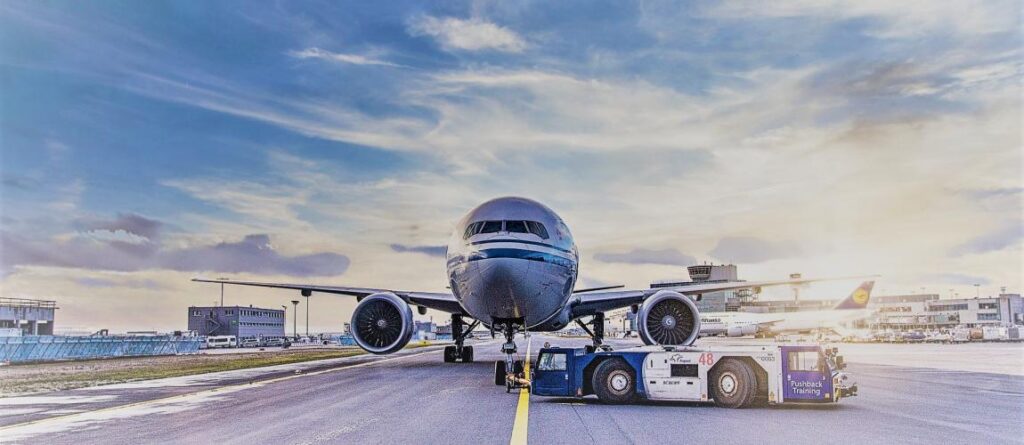EMMA Systems Seeks U.S. Expansion: A Q&A With the Co-Founders


EMMA, a new platform that leverages AI and ML to transform airport operations, is looking towards expansion in the U.S. EMMA made its debut at Qatar’s Hamad International Airport. (Photos: EMMA Systems)
EMMA Systems, a company backed by Qatar Foundation’s Qatar Science & Technology Park (QSTP), is planning to expand its advanced AI and ML platform, EMMA, in the U.S. EMMA, short for “Environmental and Movement Monitoring for Airports,” was initially introduced at Qatar’s Hamad International Airport and has garnered interest from 70 airports worldwide.
This platform aims to revolutionize airport operations by leveraging AI and ML technologies. By effectively managing various data points, EMMA provides valuable insights into flight patterns, including taxi and turnaround times. This enables airports and stakeholders to make informed decisions, significantly reducing delays and improving overall efficiency. EMMA is also highly adaptable in order to meet the unique operational requirements of different airports.
Inefficient communication between airports, airlines, and air traffic controllers often leads to time and revenue losses, as well as suboptimal processes. EMMA addresses these challenges by improving coordination and providing greater visibility into all aspects of airport operations. As a result, it enhances efficiency, increases on-time arrivals and departures, and contributes to a substantial reduction in CO2 emissions.
Flight delays have long been a persistent issue in the aviation industry. Recent data from the U.S. Department of Transportation reveals that between January 2019 and February 2023, 5.8% of flights (equivalent to 1.6 million flights) experienced delays caused by circumstances within the airlines’ control. These delays have significant financial implications, with the annual cost estimated at $33 billion.
Due to the approaching summer travel season, U.S. airports will once again face scrutiny, particularly because of the challenges posed by outdated systems and the ongoing shortage of air traffic controllers. EMMA’s entry into the U.S. market presents a compelling solution to these issues. The company’s co-founders will initiate their U.S. venture in Silicon Valley, where they plan to engage with key stakeholders in aerospace, aviation, innovation, and entrepreneurship.
Although breaking into the U.S. aviation industry can be challenging for startups, EMMA’s co-founders view the current landscape as an opportunity for innovation. They firmly believe that the existing aviation model in the United States needs to change, and they are eager to contribute to its transformation.
As the demand for air travel continues to grow, the need for better solutions becomes increasingly pressing. EMMA’s advanced platform and its ability to optimize airport operations have the potential to reshape the industry, ensuring more efficient and reliable air travel experiences.
Below, check out our question-and-answer session with the two co-founders of EMMA Systems: Wisam Costandi, CEO, and Mohammad Hourani, COO.
Avionics International: How does EMMA leverage AI and ML to transform airport operations and the commercial aviation sector?
WISAM: EMMA leverages AI and machine learning to optimize airport operations and enhance collaboration among stakeholders where they can communicate through a single platform. Today, the aviation industry relies on archaic, legacy systems that are vastly inefficient, and in many cases, stakeholders are not talking to each other from a systematic point of view.
When compared to other industries, aerospace and defense has one of the lowest investments in R&D, yet the aviation industry is striving for cost-efficient innovations to improve operations. Airports already have plenty of data from the various stakeholders, so the question is how to capture and use this data, and ultimately transform it into meaningful information that can be used for better decision-making and optimization.
EMMA brings seamless information and data sharing to all stakeholders, so the data is not siloed within divisions, thereby increasing efficiency in the operations while reducing the industry’s carbon footprint. Then, we add a level of intelligence and predictability through our AI so if unforeseen circumstances arise, stakeholders are notified well ahead of time.
MOHAMMAD: During the flight cycle, several procedures occur repetitively, such as landing, taxiing in, turnaround, taxiing out, and take-off. By utilizing historical data, we have the potential to forecast taxi-in times based on specific circumstances like weather conditions or peak hours. Regrettably, a substantial amount of historical data currently stored in the database remains unused.
By accurately predicting these activities, we can proactively identify disruptions or potential delays for specific flights. This valuable information can be shared with the relevant partners, enabling them to make informed decisions and improve their overall decision-making process.
Avionics: Can you provide more details about EMMA’s ability to manage data points and provide insights into flight patterns, taxi time, and turnaround time?
MOHAMMAD: EMMA has robust capabilities when it comes to managing data points and offering insights into flight patterns, taxi time, and turnaround time. Here are some details:
- Data Management: EMMA is designed to seamlessly integrate with multiple data sources from various airport stakeholders, including ATC (Air Traffic Control), airlines, airports, ground handlers, and other relevant entities. Upon receiving data, EMMA performs thorough validation processes to ensure data accuracy and reliability. Subsequently, it utilizes this validated data to predict the key timestamps throughout the flight cycle. This integration with diverse data sources empowers EMMA to provide comprehensive and reliable insights into flight operations.
- Flight Patterns: By analyzing historical flight data, EMMA can identify patterns in flight routes and timings. It can detect if there is any potential disruption or delays on a certain flight.
- Taxi Time: EMMA leverages historical taxiing data, considering factors like airport layout, taxiway congestion, and prevailing weather conditions, to provide accurate predictions of taxi times. It considers many variables to anticipate potential delays or bottlenecks during taxiing operations.
- Turnaround Time: EMMA examines historical data related to aircraft turnaround, including ground handling processes, servicing, refueling, and cargo handling. As a result, it can identify areas for improvement and suggest measures to minimize turnaround time, leading to more efficient operations.
- Insights and Reporting: EMMA utilizes advanced analytics and algorithms to generate insights and KPI reports based on the analyzed data. These insights help airlines and airport authorities make informed decisions about resource allocation, operational improvements, and contingency planning.
Overall, EMMA’s data management capabilities, combined with its ability to provide insights into flight patterns, taxi time, and turnaround time, offer significant advantages in optimizing operational efficiency and facilitating proactive decision-making within the aviation industry.
WISAM: While 80% of the world has never flown, this percentage is decreasing. In the coming years, there will be a tremendous growth in aviation as air travel becomes more accessible to the world. The amazing post-Covid recovery is accelerating this trend. This means we need innovative, data-driven solutions quickly to ensure the industry’s growth is sustainable.

Avionics: What specific features and capabilities does EMMA offer that make it a groundbreaking platform for airport operations?
WISAM: There is a clear lack of innovation in the aviation sector. With legacy players acting as gatekeepers to innovation, coupled with the slow sales cycle in the industry, it is difficult for start-ups to grow and innovate in this vertical. There is a lot of investment in R&D required and the ROI is not always immediately realized in the short-term. Fortunately for us, we have some of the newest and most progressive airports in our region looking to deploy advanced solutions, starting with our first deployment at Hamad International Airport (HIA). Our versatile technology stack allowed us to rapidly deploy our information-sharing platform giving graphical visibility to the operations. We realized the potential of what we built, and we were able to continue our product development thanks to a grant from the Qatar Science & Technology Park (QSTP), a member of Qatar Foundation, that allowed us to develop the AI aspects as well the messaging tool and the collaborative decision-making. QSTP’s Tech Venture Fund provides seed funding and follow-on capital to start-ups like ours that they see as having a high potential for global growth.
Beyond our technology, our deployments are turnkey. We work with airports on a gap analysis, concept of operations (ConOps), and of course their technology platforms. Our holistic approach ensures that all the stakeholders are on the same page. We understand that deploying a new tech platform without having all the players trained and on board is a waste.
MOHAMMAD: At EMMA, our approach is distinct from other legacy solution providers as we strive to develop innovative, agile, and affordable solutions tailored for airports and airlines.
We prioritize the following key aspects:
- Data Sharing: EMMA serves as the single source of information, ensuring consistent and reliable data sharing among all stakeholders involved.
- Predictability: By harnessing the power of data, EMMA leverages predictive analytics to anticipate key timestamps and potential delays, empowering proactive decision-making.
- Configurability: Recognizing the unique characteristics of each airport, EMMA offers full configurability, allowing for flexibility and adaptation to diverse airport requirements rather than relying on rigid customization.
- Communication: EMMA facilitates seamless communication and messaging among stakeholders, eliminating the need for outdated means of communication. This ensures efficient collaboration and coordination.
- Data Privacy: We prioritize the confidentiality of airline data. EMMA incorporates role-based permissions, enabling precise control over data-sharing and ensuring the privacy and security of sensitive information.
Can you elaborate on EMMA’s configurability and how it adapts to the varying operations of different airports?
WISAM: Each airport is unique with its own operating procedures and IT systems, making flexibility a key element of the EMMA platform. On the backend, our integration bridge allows us to connect and bring in a wide array of data sources. On the front end, it’s also highly configurable giving the users access to the data they require as per the standard operating procedures. Beyond that, we need to abide by each country’s local and civil aviation regulations.
MOHAMMAD: EMMA’s configurability lies in its ability to adapt and accommodate the varying operations and requirements of different airports. Here are some specifics on how we achieve this:
- Customizable Parameters: EMMA provides customizable parameters that enable airports to define and adjust various operational variables according to their ConOps or other specific needs. By tailoring these parameters, airports can fine-tune EMMA to align with their unique operations.
- Modular Architecture: EMMA is built with a modular (Microservices) architecture, allowing for the addition or removal of specific functionalities as per the airport’s requirements. This modular design ensures that EMMA can be scaled, configured, and extended with ease, accommodating the evolving operational needs of airports.
- Integration Capabilities: EMMA is designed to integrate seamlessly with existing systems and data sources at airports. It can integrate with various information systems, such as airline systems, ground handling systems, and airport databases, enabling efficient data exchange and ensuring compatibility with the airport’s existing infrastructure.
- Configurable Reporting and Analytics: EMMA provides configurable reporting and analytics capabilities, allowing airports to define and generate reports specific to their operational metrics and key performance indicators. This flexibility enables airports to obtain valuable insights tailored to their unique operations and requirements.
The post EMMA Systems Seeks U.S. Expansion: A Q&A With the Co-Founders appeared first on Avionics International.
—————
Boost Internet Speed–
Free Business Hosting–
Free Email Account–
Dropcatch–
Free Secure Email–
Secure Email–
Cheap VOIP Calls–
Free Hosting–
Boost Inflight Wifi–
Premium Domains–
Free Domains





